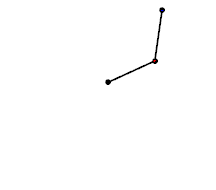cas/taxonomy/field.php (field)

Assemblage Geography
Might the world we live in be made up of contingent, emergent 'assemblages'? If so, how might complexity theory help us understand such assemblages?
Assemblage geographers consider space in ways similar to relational geographers. However, they focus more on the temporary and contingent ways in which forces and flows come together to form stable entities. Thus, they are less attuned to the mechanics of how specific relations coalesce, and more to the contingent and agentic aspects of the assemblages that manifest.
Assemblage draws from the work of Gilles Deleuze who coined the term 'agencement' (translated to "assemblage" in English) which in the original French refer both to "coming together' as well as to 'agency'. The philosophy draws attention to the contingency of material things as well as their agentic power: emphasizing that things retain both virtual capacities, which remain latent, as well as ones that are actualized when entering into relation with other forces or actors.
Example:
Consider the power of a mongol warrior. Here three separate entities, the individual warrior, the horse that he rides, and the stirrup that enables him to stand with his weapon while in motion. Each of these separate aspects cannot conquer a territory on their own, but together the three entities can enter into an assemblage that has additional agentic power to have a major effect. Such an assemblage can 'stabilize' into this configuration, while each component still maintains its own identity. Assemblage provides a way to speak about such entities, but also about how certain capacities can be latent within entities until they are forged together in contingent, temporary assemblages.
Relation to Complexity
Assemblage theorists adopt the concept of Emergence, but engage with it in a much more philosophical manner. Following the works of the philosophers Gilles Deleuze and Felix Guattari, they describe concrete urban entities as emergent, indeterminant and historically contingent Stabilized Assemblages. Assemblages are configurations of inter-meshed forces and distributed agencies - human/non-human, local/non-local, material, technical, social, etc., that are stabilized at particular moments. Once in place assemblages - like emergent features - may have unique properties or capacities not associated with their constituent elements, and thereupon yield agency in structuring further events. 'Assemblage' ideas therefore echo those of Emergence: something is produced from constituent agents that is able to act in novel ways. This conceptual overlap has led geographer Kim Dovey to suggest that the phrase 'Complex Adaptive Assemblage' be used in place of 'Complex Adaptive System' in the spatial disciplines.
Agents in a particular assemblage have particular capacities which one might see as analogous to Degrees of Freedom, but how these capacities manifest is subject to Contingency: predicated on the nature of flows, forces, or the Patterns of Interactions at play in a given situation. Assemblage geographers thus import the language of Non-Linearity and Bifurcations: trying to understand the chance events that determine the trajectory of urban systems which are sensitive to historical unfolding.
This sense that History Matters, runs counter to the historical determinism that previously dominated geographical investigations, where a coherent logical chain of cause and effect was seen as the primary driver of outer geographical difference. For assemblage thinkers, history does indeed matter, but only insofar as one particular trajectory is realized vs another. Manuel de Landa, for example, argues that in order to properly conceptualize the importance of any given actualized geographical space, it is necessary to see this space as but a single manifestation - situated within the broader Phase Space of The Virtual - with all its unrealized potentials. This emphasis on the role of history situates urban systems as subject to Contingency, with actual unfolding representing only one possible trajectory of broader system potential.
Assemblage Geography thus engages with many concepts present in Complex Adaptive Systems Theory, but primarily focuses on the nature of contingent, causal flows (including both human and non-human flows) and how these come to be realized in particular physical manifestations.
Accordingly, the field is less attuned to aspects of complexity surrounding, for example, rule-based systems, mathematical regularities, or the adaptive capacities of bottom-up agents.
Back to Complexity & Urbanism
Back to Navigating Complexity
Photo Credit and Caption: Fun image of connections and stuff (unknown)
Cite this page:
Wohl, S. (2022, 13 June). Assemblage Geography. Retrieved from https://kapalicarsi.wittmeyer.io/taxonomy/assemblage-geography
Assemblage Geography was updated June 13th, 2022.
Nothing over here yet
This is the feed, a series of related links and resources. Add a link to the feed →
Nothing in the feed...yet.
This is a list of People that Assemblage Geography is related to.
Assemblage Geography
This is a default subtitle for this page. Learn more →New Materialism | Deleuze
Content coming soon! Learn more →Informalities/Assemblage Geography
This is a default subtitle for this page. Learn more →Philosophy | The Virtual | Assemblage
This is a default subtitle for this page. Learn more →Assemblage Geography
This is a default subtitle for this page. Learn more →Assemblage Geography
This is a default subtitle for this page. Learn more →Urban Assemblages
fixed image Learn more →This is a list of Terms that Assemblage Geography is related to.
This term is used by relational/assemblage philosophers to speak about the 'space of possibilities'.
'The Virtual' is a term used by Deleuze and Guattari that parallels the idea of {{phase-space}}. The Virtual alludes to aspects of reality that may or may not manifest, depending on how a system comes to be activated. Learn more →A concept from Deleuzian philosophy - when distinct entities settle into synergies and act as a unit.
Relates to {{Assemblage-Geography}}
Learn more →The rhizome is a concept coined by french philosophers Deleuze and Guattari to describe a network of relations that resemble the structure of roots
All points are interconnected and interdependent, unfolding in a nonlinear manner with no central source of authority.
Learn more →Phase space is an abstract concept that refers to all possible behaviors available to an agent within a complex system.
Related to {{degrees-of-freedom}}. Learn more →A particular topological space that a system can occupy
This is a default subtitle for this page. Learn more →Complex system behaviors are highly contingent.
Details of the specific historical trajectory a complex system follows can have a huge impact on system behavior Learn more →The idea that many possible states or historical trajectories could have equally unfolded
Beyond its day-to-day usage, this term used in now employed in the social sciences to highlight the Path Dependency exhibited in many social systems. This is seen to contrast with prior conceptions like "the march of history", which imply a clear causal structure. By speaking about the work as something contingent, it also begs the question of what other "worlds" might have just as equally manifested, had things been slightly different.
Similar ideas are captured in the ideas of Non-Linearity, {{sensitivity-to-initial-conditions}}, History Matters.
Pictured below: the contingent trajectory of the double pendulum:

Learn more →
This is a list of Urban Fields that Assemblage Geography is related to.
Tactical interventions are light, quick and cheap - but if deployed using a complexity lens, could they be a generative learning tool that helps make our cities more fit?
Tactical Urbanism is a branch of urban thinking that tries to understand the role of grassroots, bottom-up initiatives in creating meaningful urban space. While not associating itself directly with complexity theory, many of the tools it employs -particularly its way of 'learning by doing' - ties in with adaptive and emergent concepts from complexity.
This is a list of Key Concepts that Assemblage Geography is related to.
Navigating Complexity © 2015-2025 Sharon Wohl, all rights reserved. Developed by Sean Wittmeyer
Sign In (SSO) | Sign In
Related (this page): Non-Linearity (26), Emergence (24), Driving Flows (25), Stabilized Assemblages (113), Rhizomes (115), Path Dependency (93), Open / Dissipative (84), Manifold (82),
Section: fields
Non-Linearity Related (same section): Urban Modeling (11, fields), Resilient Urbanism (14, fields), Relational Geography (19, fields), Landscape Urbanism (15, fields), Evolutionary Geography (12, fields), Communicative Planning (18, fields), Assemblage Geography (20, fields), Related (all): Tipping Points (218, concepts), Path Dependency (93, concepts), Far From Equilibrium (212, concepts),
Nested Orders Related (same section): Urban Modeling (11, fields), Urban Informalities (16, fields), Resilient Urbanism (14, fields), Related (all): Self-Organized Criticality (64, concepts), Scale-Free (217, concepts), Power Laws (66, concepts),
Emergence Related (same section): Urban Modeling (11, fields), Urban Informalities (16, fields), Urban Datascapes (28, fields), Incremental Urbanism (13, fields), Evolutionary Geography (12, fields), Communicative Planning (18, fields), Assemblage Geography (20, fields), Related (all): Self-Organization (214, concepts), Fitness (59, concepts), Attractor States (72, concepts),
Driving Flows Related (same section): Urban Datascapes (28, fields), Tactical Urbanism (17, fields), Relational Geography (19, fields), Parametric Urbanism (10, fields), Landscape Urbanism (15, fields), Evolutionary Geography (12, fields), Communicative Planning (18, fields), Assemblage Geography (20, fields), Related (all): Open / Dissipative (84, concepts), Networks (75, concepts), Information (73, concepts),
Bottom-up Agents Related (same section): Urban Modeling (11, fields), Urban Informalities (16, fields), Resilient Urbanism (14, fields), Parametric Urbanism (10, fields), Incremental Urbanism (13, fields), Evolutionary Geography (12, fields), Communicative Planning (18, fields), Related (all): Rules (213, concepts), Iterations (56, concepts),
Adaptive Capacity Related (same section): Urban Modeling (11, fields), Urban Informalities (16, fields), Tactical Urbanism (17, fields), Parametric Urbanism (10, fields), Landscape Urbanism (15, fields), Incremental Urbanism (13, fields), Evolutionary Geography (12, fields), Related (all): Feedback (88, concepts), Degrees of Freedom (78, concepts),
